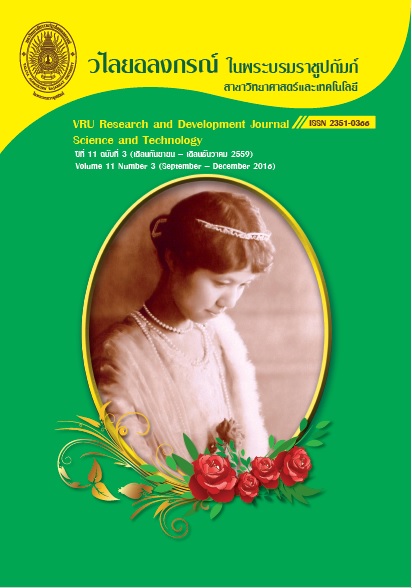ผลของไซโตไคนินและออกซินต่อการเจริญและพัฒนาของการเพาะเลี้ยงเนื้อเยื่อสับปะรด
Main Article Content
Abstract
สับปะรด (Ananus comosus cv. Patavia) เป็นพืชเศรษฐกิจที่สำคัญของประเทศไทย ซึ่งผลผลิตส่วนถูกส่งเข้าโรงงานอุตสาหกรรมเพื่อผลิตสับปะรดกระป๋อง น้ำสับปะรดเข้มข้น ดังนั้นงานวิจัยนี้จึงมีวัตถุประสงค์เพื่อศึกษาผลของสารควบคุมการเจริญเติบโตกลุ่มไซโตไคนินและออกซินต่อการเพาะเลี้ยงสับปะรด ในสภาพปลอดเชื้อ โดยใช้แผนการทดลองแบบสุ่มสมบูรณ์ จำนวน 4 ซ้ำ และวิเคราะห์ผลการทดลองด้วยการวิเคราะห์ความแปรปรวน และเปรียบเทียบความแตกต่างของค่าเฉลี่ยด้วยวิธี Least Significant Difference (LSD) ที่ระดับความเชื่อมั่น 0.05 จากการทดลองพบว่าสามารถชักนำให้เกิดต้นใหม่ได้จำนวนต้นสูงสุดในอาหารสูตร MS ที่เติม BAP 1 มิลลิกรัมต่อลิตร จำนวน 4.25 ต้น ในสัปดาห์ที่ 10 และเกิดการพัฒนาเป็นแคลลัสเฉพาะสูตรที่เติม BAP 1 2 และ 3 มิลลิกรัมต่อลิตร ในระยะต่อมา สำหรับอาหารที่เหมาะสมต่อการชักนำราก คือ อาหารสูตร MS ที่เติม NAA 2 มิลลิกรัมต่อลิตร มีรากเกิดขึ้น จำนวน 16 ราก เมื่อเพาะเลี้ยงเป็นเวลา 10 สัปดาห์
Pineapple (Ananus comosus cv. Patavia) is an important economic crop in Thailand, which the mainly products were sent to manufacture for canned pineapple and pineapple juice concentrate. The effects of plant growth regulators cytokinin and auxin on growth of pineapple in sterile conditions were studied and the experiments were carried out in a Completely Randomized Design (CRD) with four replications. An Analysis of variance (ANOVA) was calculated and means were compared using Least Significant Difference (LSD) at the 0.05 level. The results found that, shoot induction, the young shoots cultured on medium with 1 mg l-1 BAP gave the maximum number of shoots at 4.25 shoots after 10 weeks culture. The callus were produced when cultured on MS medium with 1, 2 and 3 mg l-1 BAP in the following stage. It was found that root induction cultured for 10 weeks on MS medium with 2 mg l-1 NAA gave the highest number of roots at 16 roots.
Downloads
Article Details
Copyright Notice
The copyright of research articles published in the VRU Research and Development Journal Science and Technology Journal belongs to the Research and Development Institute, Valaya Alongkorn Rajabhat University under the Royal Patronage. Reproduction of the content, in whole or in part, is prohibited without prior written permission from the university.
Responsibility
The content published in the VRU Research and Development Journal Science and Technology Journal is the sole responsibility of the author(s). The journal does not assume responsibility for errors arising from the printing process.
References
กรมวิชาการเกษตร. (2555). ความสำคัญของสับปะรด, 12 เมษายน 2557. http://www.doa.go.th
ปวิณ ภิรมย์, อรวรา ดำนิล, ปณิดา ศิลารัตน์ และพัชรา พงศ์มานะวุฒิ. (2553). การเพาะเลี้ยงเนื้อเยื่อ, 4 มกราคม 2557. http://www.thaigoodview.com/library/contest2553.
ภาควิชาพืชไร่นา คณะเกษตร มหาวิทยาลัยเกษตรศาสตร์. (2555). ความสำคัญของสับปะรด, 15 เมษายน 2557. แหล่งที่มา http://ait.nisit.kps.ku.ac.th/dbfieldcrop/importtant/pineapple.htm
มหาวิทยาลัยแม่โจ้. (2556). การผลิตสับปะรด, 23 กันยายน 2557.
ศิริชัย อุ่นศรีสงค์. (2550). โปรแกรมวิเคราะห์ทางสถิติ Sirichai Statistics 6.07, 3 กรกฎาคม 2557
http:// www.agric-prod.mju.ac.th/agronomy/
สำนักงานเศรษฐกิจอุตสาหกรรม. (2557). โครงสร้างอุตสาหกรรมสับปะรด, 23 กันยายน 2557
http://www.nfi.or.th/vc-pineapple/index.php/pineapple.../st09/94-pine
Be, L.V. and Debergh, P.C. (2006). Potential low-cost micropropagation of pineapple (Ananas comosus). South African Journal of Botany 72, 191 – 194.
Sripaoraya, S. ,Marchant, R., Power, J. B. and Davy, M.R. (2003). Plant regeneration by somatic embryogenesis and organogenesis in commercial pineapple (Ananas comosus L.). In Vitro Cell 39, 450-454.
Zheng, J., Li, H. and Gan, Y. (2005). Studies on tissue culture and rapid propagation with low cost of pineapple cultivar. Mibao. Mintai Horticultural Research Center, Fujian Academy of Agricultural Sciences, Zhangzhou, Fujian China.


